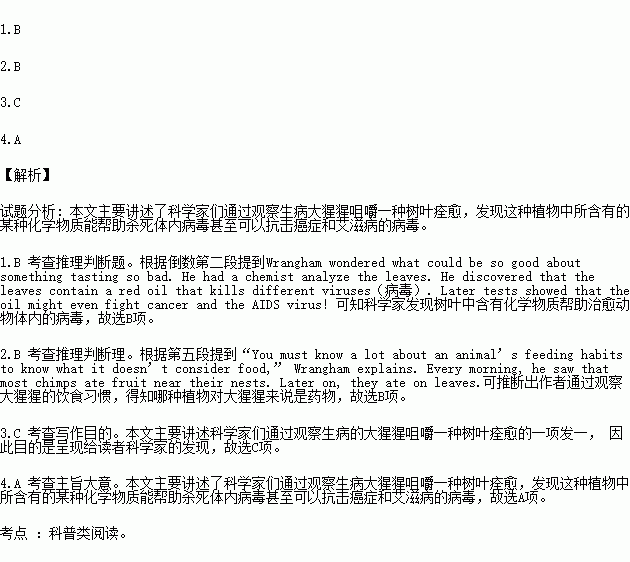题目内容
The chimp didn’t feel well. She fell over, ignoring the other wild chimps. Finally, the sick chimp crawled over to a bush, picked some leaves and swallowed them. By the next afternoon, the chimp was as good as new!
Biologists watching the chimp were surprised. Somehow, the plant had cured the chimp! Did the chimp know the plant would make her feel better? Or was it just a lucky accident?
Many scientists don’t think it has anything to do with luck. They’re discovering that some animals seem to use plants to cure themselves. And these animals are leading scientists to new plants that could cure humans!
Dr. Richard Wrangham, an anthropologist at Harvard University, agrees that animals may know something we don’t know about forest plants.
Wrangham got to know chimps and their diets while studying them for three years in Tanzania. “You must know a lot about an animal’s feeding habits to know what it doesn’t consider food,” Wrangham explains. Every morning, he saw that most chimps ate fruit near their nests. Later on, they ate on leaves.
When he noticed chimps eating the leaves of a plant they usually ignored, Wrangham thought something interesting was going on---especially when he saw that they’d sometimes walk for 20 minutes to find the plant. Another strange thing that caught his eye was how they ate the bitter leaves.
“They swallowed the leaves whole,” explains Wrangham, noting that chimps usually chew their food well. “They seemed to rub(摩擦)the leaves around the roofs of their mouths. They closed their eyes, wrinkled their noses and swallowed slowly. ”
Wrangham wondered what could be so good about something tasting so bad. He had a chemist analyze the leaves. He discovered that the leaves contain a red oil that kills different viruses(病毒). Later tests showed that the oil might even fight cancer and the AIDS virus!
Why don’t the chimps chew the leaves? “Rubbing the leaves between the tongue and the inside of the mouth might allow the chemicals to enter the bloodstream directly,” he suggests, “instead of going to the stomach, where they might get destroyed by acids. The chimps seem to know what they’re doing.”
1.We can learn from the passage that _________.
A. chimps cure themselves by chewing plants
B. chemicals in plants help cure animals
C. scientists live with chimps to study their diets
D. Dr. Wrangham knows a lot about forest plants
2.How can Dr. Wrangham tell which plants are medicine for chimps?
A. By talking with the biologists.
B.. By studying the chimps’ feeding habits.
C. By analyzing the chimps’ favorite food.
D. By comparing other scientists’ discoveries.
3.The author wrote the passage to ___________.
A. provide a solution B. test a theory
C. present a finding D. describe an experiment
4.What does the passage mainly talk about?
A. Animal doctors. B. Forest plants.
C. Chimp’s diets. D. A cure for cancer.



 the stars in outer space. Photos also tell stories.
the stars in outer space. Photos also tell stories. Each picture is like a chapter in a book, which can do more than record the facts. It can also be a strong force for social change.
Each picture is like a chapter in a book, which can do more than record the facts. It can also be a strong force for social change.